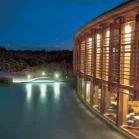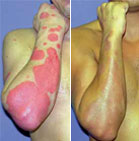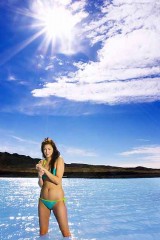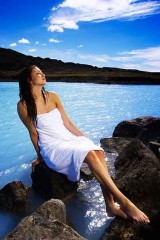Geothermal Energy
How GE is used in Iceland
Steam Power in Iceland
High and Low Temp Fields
Icelandic Spaas
Thermal Waters of Hungary
Geothermal Energy
Geothermal Energy in Hungary
Spas in Budapest
Spas in Hungary
How GE is used in Iceland
Steam Power in Iceland
High and Low Temp Fields
Icelandic Spaas
Thermal Waters of Hungary
Geothermal Energy
Geothermal Energy in Hungary
Spas in Budapest
Spas in Hungary
The Blue Lagoon is situated on Reykjanesskagi near Grindavík and is about 23 km from Leifsstöð, the international airport and 43 km from the capital Reykjavík. The Lagoon is just about 10 km away from the ocean.
Next to the lagoon is the power plant Svartsengi which provide the inhabitants of Reykjanesskagi with electricity and hot water. About 90 people make their living at the lagoon, serving or treating people but guests are over 100.000 annually. The lava at Reykjanesskagi is very porous and the it isn't very solid that it easily lets sea flow through it. The Blue Lagoon developed when hot earth sea, which came from the hot changes from the power plant, was pumped out into nearest lava field.
![]()
In the year 1973 a new steam-powers station was built in Svartsengi, but this power plant was one of a kind in the world at that time. To use hot subterranean sea water to heat up freshwater that is later used to warm up homes had never been done before but many technical problems had to be solved first.
It was said that an employee, who had the psoriasis skin disease, started to bath himself at the lagoon after the plant work began to pump the subterranean sea water out into the nearest lava fields and he got much, much better. Thereafter more and more psoriasis patients came to bathe there, and it helped them a lot if they had bathed there a couple of times a week. But the influence of the water has not t confirmed till later. It was then confirmed with research and then onwards almost every psoriasis patient here in Iceland had begun bathing there.
1992 there was established a company there, named Blue Lagoon. The company built a changing room facility, a hotel and a souvenir shop. The spa is well known and had been chosen the worlds best natural spa, one of the most amazing bathing places and one of 25 best spas in the world. In 1993 there was built there a therapeutic station for psoriasis and eczema patients and in the year 1995 they began manufacturing products for the human skin. A new Dermatology Clinic will open in spring 2005 by the Blue Lagoon.
 At Svartsengi they are drilling holes up to two thousand meters deep down. They scrape through underground kettle that is full of subterranean sea water. The subterranean sea water is mixed up from subterranean sea water (65%) and freshwater (35%). The temperature there is about 240°C. Chemicals fall out of surrounding rocks, which is very high with silicon changing the chemical, boosting up the silicon 100x (430 mg/kg) but on the other hand the magnesium content reduces 1000 times. The plant work uses this liquid to make electricity and hot water to heat up houses for the inhabitants. The subterranean sea water is then pumped out over the nearest lava fields, but about 900m³ are pumped over the lava fields every hour. When the procedure has reached this point the subterranean sea water has cooled down from 240°C to 70°C. When the subterranean sea water (liquid) cools down the subterranean sea water supersaturates of silicon and long chains of silicon molecule show up. The silicon molecule then fall out and out of that comes the white mud that settles
At Svartsengi they are drilling holes up to two thousand meters deep down. They scrape through underground kettle that is full of subterranean sea water. The subterranean sea water is mixed up from subterranean sea water (65%) and freshwater (35%). The temperature there is about 240°C. Chemicals fall out of surrounding rocks, which is very high with silicon changing the chemical, boosting up the silicon 100x (430 mg/kg) but on the other hand the magnesium content reduces 1000 times. The plant work uses this liquid to make electricity and hot water to heat up houses for the inhabitants. The subterranean sea water is then pumped out over the nearest lava fields, but about 900m³ are pumped over the lava fields every hour. When the procedure has reached this point the subterranean sea water has cooled down from 240°C to 70°C. When the subterranean sea water (liquid) cools down the subterranean sea water supersaturates of silicon and long chains of silicon molecule show up. The silicon molecule then fall out and out of that comes the white mud that settles  down on the bottom and condenses making the lagoon even bigger. In 1999 the lagoon was about 200 meters wide and a couple of km long. The depth is 1-3 meters almost everywhere. The name Blue Lagoon came because when the light hits the water it shatters because of the magnitude of the silicon (140 mg/kg) and turns to blue.
down on the bottom and condenses making the lagoon even bigger. In 1999 the lagoon was about 200 meters wide and a couple of km long. The depth is 1-3 meters almost everywhere. The name Blue Lagoon came because when the light hits the water it shatters because of the magnitude of the silicon (140 mg/kg) and turns to blue.
Now there is a treatment facility there specialized in treading psoriasis and that has worked unbelievable well. Here on the other side is a photo of a man who went into treatment and the results are unbelievably good. The guests at the treatment facility are mostly from Iceland, Denmark and Faeroe Islands, but the guests are from over 15 countries.
The earth-baths at Mývatn are used for health-remedies. It is the heat in the earth and it is the only place in Iceland where clean water vapour that comes up which is devoid of brimstone and steam.
In the year 1940. it was the first time that people built over steam hole at Mývatn and the holes were used for ages as  steam baths. People know about more steam holes there, which were used there about and in the year 1996 it was decided to use these baths so the culture and the story of Mývatn would be preserved. These baths were right away a smash hit and in the year 1998, a limited liability company started there, which made this magnificent bath leverage in the Mývatns district. The owners of the earth-baths are about 80 and the state power owns the majority of the organization. The National Power Company supports them by donating hot separated water from the steam system in Bjarnarflag. It is taken care that the construction fits the nature in Mývatnssveit. In those earth-baths at Mývatn is a bath-lagoon with a geyser water, naturally sauna, a hot pool and there is also a store.
steam baths. People know about more steam holes there, which were used there about and in the year 1996 it was decided to use these baths so the culture and the story of Mývatn would be preserved. These baths were right away a smash hit and in the year 1998, a limited liability company started there, which made this magnificent bath leverage in the Mývatns district. The owners of the earth-baths are about 80 and the state power owns the majority of the organization. The National Power Company supports them by donating hot separated water from the steam system in Bjarnarflag. It is taken care that the construction fits the nature in Mývatnssveit. In those earth-baths at Mývatn is a bath-lagoon with a geyser water, naturally sauna, a hot pool and there is also a store.
In these bath-lagoons run a geothermal fluid and the water is about 130°C, but it is treated in heat exchanger before it is pumped in the lagoon. The water is transported with vapour tension and it  goes into a large tub abreast the lagoons before it is pumped into the lagoons. It is about 3,5 millions liters of water in those lagoons. The temperature is about 36-40°C. The lagoons are ready-made constructions with tight sand and a gravel bottom.
goes into a large tub abreast the lagoons before it is pumped into the lagoons. It is about 3,5 millions liters of water in those lagoons. The temperature is about 36-40°C. The lagoons are ready-made constructions with tight sand and a gravel bottom.
The water in the lagoon is very special. It embraces much volume of mineral and it is alkaline and therefore it is good to bathe in. Because of the geochemical analysis of the geothermal water there are no bacteria or vegetation in the lagoon. So it isn't necessary to mix chlorine in the water.
In the water there is much of brimstone, so people shouldn't wear jewelry of copper and of silver when they are bathing in the lagoon. The brimstone is considered to have good effects on asthma and many of the trace elements are considered to have good effects on skin-problems.
The district Mývatnssveit is known for its unique natural beauty and rich bird life. Mývatn is one of the most popular tourist places of Iceland. The areas offers a lot of entertainment, both during summer and  winter. Mývatn is at a 277 meters elevation and it is the fourth biggest lake of Iceland. The name of the lake is Mývatn because there are so much of gnats there.
winter. Mývatn is at a 277 meters elevation and it is the fourth biggest lake of Iceland. The name of the lake is Mývatn because there are so much of gnats there.
Due to the area's varied and rich bird life, it is supposed that nowhere in the world are more ducks types in just once place. The barrows golden eye just lays its eggs in Mývatn on Europe. In the Mývatn district are lot of walkways and the scenery is wonderful there.
Written by Hróðmar and Sædís